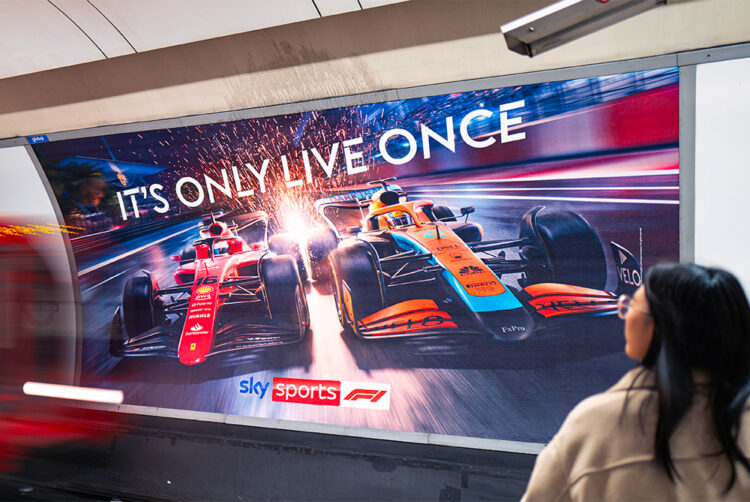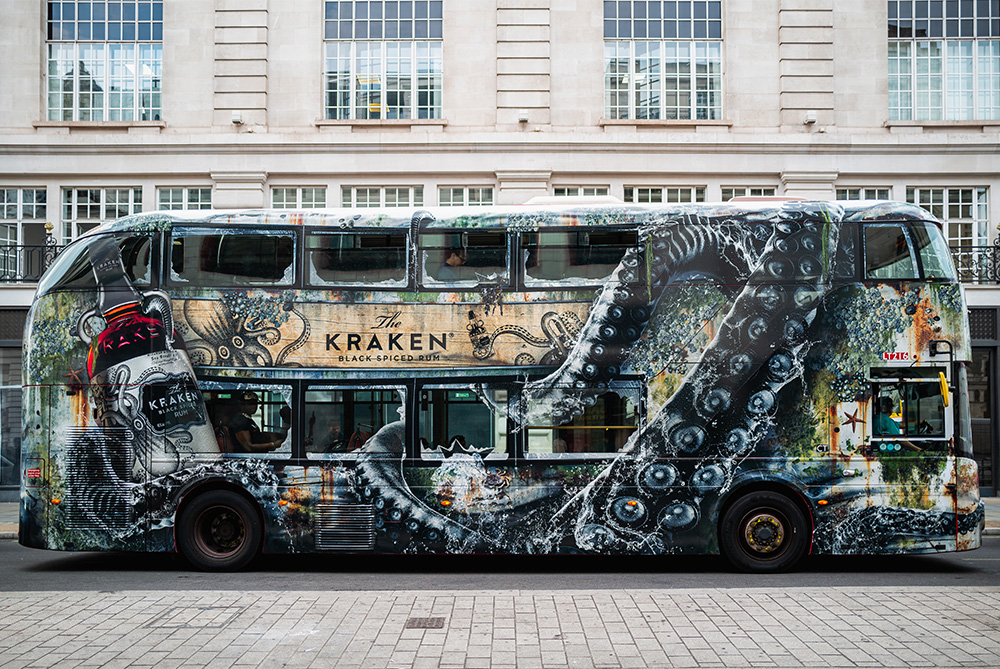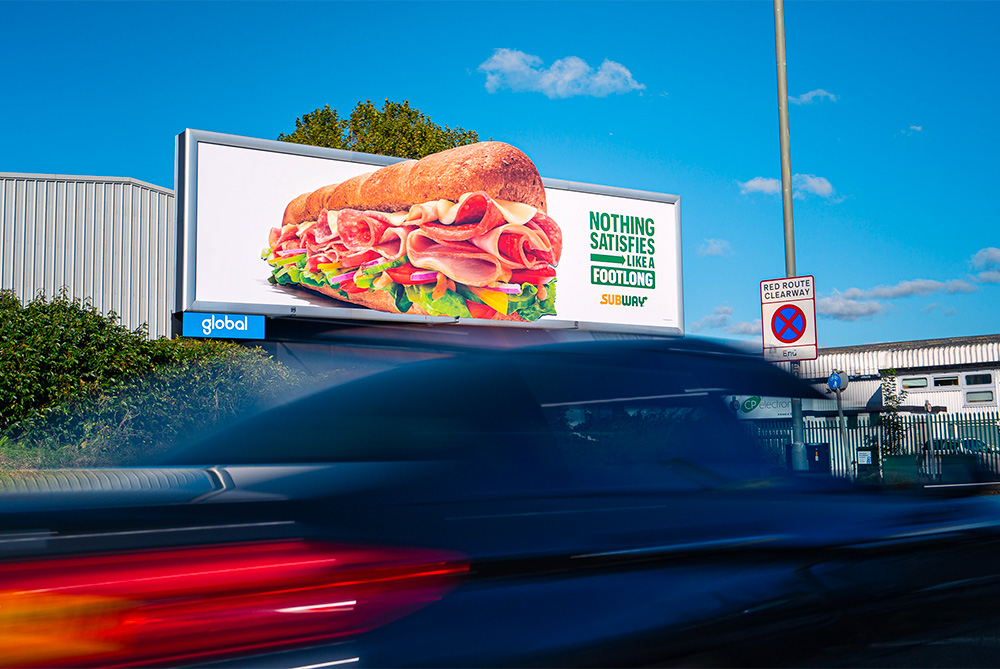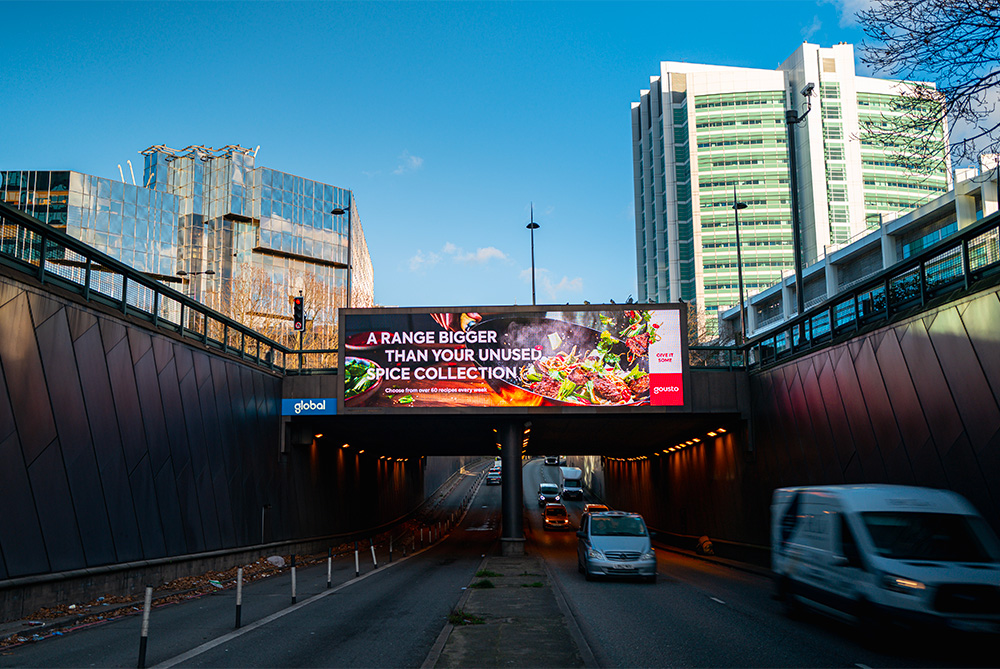Bringing brand-building back on the agenda in outdoor

Special Feature
Three years after shaking up the UK out-of-home history with a flurry of acquisitions, Global sees an opportunity for bringing back brands on screens and posters. But do advertisers and agencies have the confidence to brand-build on OOH when belts are tightening and the ‘brand vs performance’ marketing divide persists?
Few media sectors have faced a tougher Covid-19 pandemic than outdoor. Not only did out-of-home (OOH) suffer from an immediate loss of advertiser demand amid the lockdowns in 2020 and 2021, but longer-term changes in people’s working and shopping patterns have forced media planners and advertisers to ask tough questions about what effective outdoor advertising now looks like.
The timing of the pandemic was especially significant for Global which had just been on acquisition spree that began in 2018 as the radio giant began to diversify into OOH media. After purchasing Primesight, Outdoor Plus, and Exterion Media, the company best known for Capital and Heart is now also the UK’s third biggest outdoor media owner.
Now having consolidated its outdoor business into a single Global outdoor division, the business has been developing its long-term vision. But how best to capitalise on the medium’s recovery?
The problem Global faces, like all so-called traditional media, is that mass market moments aren’t what they used to be—audiences are fragmenting and media-buying options have splintered into declining reach and unequal impacts.
However, as advertisers look to rebalance their media plans, the company is confident that one place where audiences remain robust is outdoor. It has just completed a 5,000 person research study with award-winning agency Differentology that proves how large-format outdoor improves brand health and creates a multiplier factor on advertising effectiveness when combined with other media channels, including salience and mental availability (argued by marketing experts Les Binet, Peter Field, and Byron Sharp as the need for a brand to come to mind quickly in relation to a specific need or occasion).
In short, Global sees a specific opportunity around offering outdoor as a brand-building solution for advertisers. But what are advertisers’ and their media agencies’ views of brand-building in an age of fragmented media and declining reach? What is the future role for brand-building when the rise of ‘performance’ media enables marketers to instantly measure the impact of their online activations? And how is the cost-of-living crisis, both felt in consumers’ pockets and advertisers’ media budgets, going to impact the view of brand-building this year and next?
These are the key questions posed to a distinguished array of senior marketers, media strategists and advertising practitioners who attended The Media Leader’s invitation-only roundtable debate at London’s Haymarket Hotel in July.
Attendees: Hannah Harris, strategy director at mSIX&Partners; Chris Forrester, director of commercial outdoor, Global; Jackie Lyons, head of planning at Havas Media Group; Ross Sergeant, head of global media and touchpoints, Asahi Europe & International; Sarah Gale, director of insight at Global; Steve Taylor, joint chief strategy officer at VCCP Media; Tom Darlington, global group strategy director at PHD; Farhann Cachra, group strategy director at Global; Ali Humphrey, European marketing director at Stella Artois, Mike Watson, creative director at Wunderman Thompson UK; Omar Oakes, editor of The Media Leader (moderator).
As the conversation developed during the afternoon, it became apparent that there is a general lack of knowledge and understanding across brands’ marketing teams about how brands work and the value of long-term advertising goals.
For example, Asahi’s global head of media, Ross Sergeant, lamented what he sees in the marketing community as a widespread misinterpretation of a key Les Binet & Peter Field insight that brands tend to spend 60% of their budgets on brand-building and 40% on performance. For more on this, watch or read The Media Leader’s interview with Sergeant in May.
According to Sergeant, too many advertisers are looking at Binet & Field as a recommendation to spend 60% of budget on brand and 40% on performance, when in fact they were making an observation that that is what happens as an aggregate (individual advertisers will have reasons to spend more or less on each depending on their marketing objectives). Binet reiterated earlier this year that 60-40 is “not an iron rule”.
Sergeant explained: “In some countries, like in Hong Kong, we have 99% awareness [and] we have 99% distribution… In some countries we’re really, really small and we need to use certain areas to do branding and that is absolutely what we use outdoor for.”
He went on: “What I do find, and it’s not just a Asahi thing but it was the same with [his previous employer] Diageo, was very often there’s a conversation around, ‘can I stick outdoor next to all of my customers? Can we put it next to the Waitroses?’

“Well, 700 billboards around England is great but we’re talking about establishing iconic status. The role of Outdoor is quite clear, it’s incredibly strong, dramatic, and big in the brand area but then Outdoor is a very broad category. I’ve worked in different countries where on street corners you have signage which you can pay for and small letters which say, ‘The McDonald’s is around the corner.’”
VCCP Media’s Steve Taylor (pictured, left) agreed—nowhere in the marketing literature does it say that a 60-40 split of brand and performance is the ‘gold standard’.
Taylor suggested this misunderstanding was even worse than Sergeant had suggested, namely that “60 goes on television and 40 goes to Google”. He warned that briefs from clients need to be clear and fall into the trap of being “formulaic” and lead to a suboptimal level of spend on different media channels.
“They often, nowadays, say, ‘I want you to spend this amount of money on Facebook,’ or ‘This amount of money here and this amount here,’” Taylor explained. “And often that’s because they manage internal teams and those budgets are already carved round.”
Is planning a dying art?
PHD’s Tom Darlington, meanwhile, stressed it was important for media agencies to be good at interpreting the client brief, namely: “getting close to that objective and then being really, really good at defining what the role for channel, the role for communications is, and then coming up with the assets and the executions that are appropriate for them.”
He suggested there is a scourge of “laziness” that leads people to misinterpret the 60-40 theory and how to invest in brand-building generally.
“We don’t bother to read under the bit of what that actually could mean. We take concepts of distinctive brand assets and sort of bastardise that. We take the idea of “fame”… but what actually does [Paul] Feldwick talk about when he says fame? It isn’t just ‘go big’, it’s to get the advertising to a point where people are singing the theme tune on the bus. Where people are talking about it in TV shows. There is a much different connotation to a lot of the theories and we are very good at stopping at entry-level psychology as far as a lot of this stuff is concerned, without really prodding a lot further.”
“The attention debate is really interesting, but it’s so narrow at the moment—what does attention mean?
Sarah Gale, Global
Ali Humphrey, European marketing director at Stella Artois, remarked that OOH was more commonly being used during the pandemic as to bring “scale and amplification to a small tactical PR initiative”. She referenced a recent stunt by Specsavers, in which special build ‘fails’ were created for its revamped Should’ve gone to Specsavers campaign.
Outdoor as a medium, it appears, brings an instant credibility and public-trust element to an ad’s creative when it is deployed in online environments—the user knows this ad is “out there” in the world and not just being served to them on their phone or computer. As media consultant Justin Gibbons as argued in his research of late, “public media” provides an effectiveness boost, too, thanks to a mental process known as Priming.
Stella Artois, Humphrey explained, already has huge brand awareness in the UK, so instead it needs to drive sales by promoting brand variants or innovations.

As an example, she pointed to a rival’s recent efforts: “You can see the model that Heineken have followed over the past few years, which is to go largely silent on Heineken but design the innovations with the memory structures that you instantly know it’s Heineken. But they dedicate them solely to 0,0 [its alcohol-free variant] and now Heineken Silver.”
For mSix&Partners’ strategy director Hannah Harris, the importance of “brand” was “mothballed” during the height of the pandemic, but has gradually been coming back as life creeps back towards normality. Now, she argued, it is essential for strategists to be given licence to make long-term decisions versus the constant pressure to address “here and now” considerations.
However, media agencies need to have the confidence internally to make the case for brand-building on the plan. Taylor warned there is a broader question of whether media planning is becoming a “dying art” and so the role of outdoor being used for brand-building is at risk of being “overlooked on advertisers’ plans.”
“You need to fit whatever that message is into an appropriate channel,” Taylor said. “It does worry me sometimes that you get a mid-weight planner [who] will come through and they can’t explain why they’ve got the channels that they’ve got [in their plans].”
And yet there is a need for large advertisers to have the expertise about different media channels so they can set better briefs.
Global’s director of commercial outdoor Chris Forrester observed that marketers generally have a “high level in what’s coming next, and a very low level of interest in stuff that’s proven”.
So-called legacy media “falls off the radar” as a consequence, Forrester went on. “But, if you want to do your job properly, you need to be permanently in touch with every part of it, in order to be able to understand for that particular client what that particular medium should be, and that particular measurement. And my sense is that that’s either not possible or not delivered.”

This appreciation of media is not just essential in order to work more effectively with agency partners, it’s a necessary part of holding them accountable, too. Sergeant (pictured, right) insisted that agencies need to be “objective” in their media planning recommendations and not be influenced by, for example, rebates from media owners.
He referenced Asahi’s relationship with Omnicom’s PHD in Australia, where the planning team is “absolutely sacrosanct, they’ve got nothing to do with the trading decisions whatsoever. Unfortunately that’s just not true everywhere. In [UK] teams, definitely not.”
Creative challenges
There was general agreement that much of this lack of clarity over briefs and channel planning was leading to poor creative outcomes on outdoor.
Havas Media Group’s Jackie Lyons said: “I know it sounds really simple but, if you get that [brief] really clear, it’s a no-brainer. I worked on Diageo for five-and-a-half years, so I’m really clear on how for Guinness we got out-of-home returns higher than TV, and that’s because we found the right role for [it] in the ecosystem and it served a certain purpose.”
So why aren’t parts of the industry able to work together to better understand purchase journeys or attention measurement, asked Sarah Gale, Global’s director of insight.
Big brands are now so obsessed with research, data, and what method is important to larger consumers, that actually that iconic nature of branding can get lost,
Jackie Lyons, Havas Media Group
“As an industry, we get so siloed into little areas,” Gale said, using attention measurement in media as an example. “The attention debate is really interesting, but it’s so narrow at the moment—what does attention mean? How can we cultivate and grab attention? That’s more interesting to me than measuring how much attention people pay to display.
She went on: “How can we reach people in the right moments and in the right context and all of those things? That’s what we should be working on together, rather than silos and competing with each other.”
The upshot of this sub-standard briefing meant that, as Humphrey remarked, the general creative quality on out-of-home was “quite average”.
She commented: “With every channel, there’s an opportunity to improve the creative that lives on that channel and that has an impact on the ROI. I’d say the level of creative that I see on out-of-home is generally quite average… There are so many messages designing against the context.”
Drawing on another effectiveness authority, Orlando Wood’s celebrated IPA research book Lemon, Lyons suggested there is a an “over-rationalisation” of what used to be iconic brand messaging.

“Big brands are now so obsessed with research, data, and what method is important to larger consumers, that actually that iconic nature of branding can get lost,” Lyons explained. “And that suffers in outdoor in particular because we have all these rational and ‘banking-type’ messages. Where is all the colour and fun?”
Lyons suggested that ad agencies should be asked to design the outdoor ads first instead of spending “so much time on 60-second scripts” for the TV execution, even if the client only allocates a couple of days of consistent TV buying at a campaign’s launch.
“[TV] is where the attention goes, but the majority of your campaign might be delivering reach through your [poster] six sheets. That’s not a fair balance,” she added.
The creative director at the table, Wunderman Thompson’s Mike Watson, agreed that “98% of creative in outdoor is terrible” because “everyone’s doing badging” rather than considering how to use posters and screens to their full creative potential.
“[Advertisers] go in and say, ‘We’ll buy a ton of space and put our badge up and people will walk around going, ‘Ah, I feel like an Asahi.’
“The point, instead, is to create outdoor ads that remind you about the Asahi brand the next time you go into a bar or the alcohol aisle in a supermarket, which entails the need for a brand-building approach.”
The cost-of-living crisis was a recurring theme throughout the discussion, with many interesting viewpoints about marketing strategies in a high-inflation environment and with the UK economy expected to fall into recession next year.
Global research, shared with the roundtable, showed that three-quarters of people in the UK have already changed something about their lifestyle in response to the inflation crisis. However, the same proportion of people still want to spend money on “what makes them happy”.

Lyons (pictured, left) confirmed this and reported that “people are looking to substitute at the moment for a cheaper brand if they can, and if they don’t see the value of the brands they buy at the moment, they will be looking for a cheaper alternative.”
The risk, according to Global’s group strategy director Farhann Cachra, was that consumers could be faced with a “value overload” when it comes to purposeful messaging during a period of high inflation.
“During Covid you had a lot of brands doing similar sort of, ‘We’re here for you’ messaging. You might end up with that, ‘We’re more cost-effective than ever,’ messaging,” Cachra explained.
“It’s the ones that are more useful that have been the ones that will do well, like Tesco Clubcard’s proposition—you know you’re going to save the money, so now people are talking about how good Clubcard is.”
What’s next for brand-building in outdoor
Cachra noted the industry is generally preoccupied with “short-termism” and needs to come up with a better language to combat it, whether it’s adopting terms like “short-term revenue decline”, or “short-term client satisfaction”.
However, there are signs that a reductive approach to “brand vs performance” decisions is waning in some quarters. Cachra relayed a recent conversation he had with a major online advertising company’s financial director about new UK rules coming into force in October to limit promotions for foods high in fat, salt, and sugar.
“He was saying, ‘look, we are really worried because of HFSS… We can’t generate half the sales in the way we used to. So we’re going to be investing in brand. I know it will pay back—it will pay back within a year—but it’s going to be a bit tetchy for the next few months.’”
Brand is back, but it’s lurked. The brand people have had their hands slapped with a ruler.”
Ross Sergeant, Asahi
Where advertisers need to focus, according to Cachra, is on “understanding deeply the opportunity around data and context” as well as challenge media planners on why they are making decisions about why different channels are being used to build brand or drive performance.
“Audience first planning has always been basically the bread and butter of media planning,” he explained. “Now we know more, but instead of making it more interesting we seem to be losing the exciting bits.”
Harris summed up a common refrain among the planning community: “My ask would be, as a strategist, to allow us to do our job in terms of thinking beyond just the here and now and actually being the guardians of that brand to secure that future growth.”
Sergeant, however, insisted he never doubted that brand was “the most important thing”, but noted that the advent of online advertising means there are now more people involved in wider business decisions that affect marketing.
“There’s not a single board in the country that Google hasn’t visited and presented to. Very often in many organisations the marketing person isn’t even on the board — sometimes they’re a level down, they don’t even get the conversation, and it creates a lot of tension. Not to say that the people at Google weren’t saying brilliant stuff, and they were, but that sort of balance became a little bit questionable. So, I do think from a UK perspective brand is back, but it’s lurked. The brand people have had their hands slapped with a ruler.”

On the other hand, Humphrey urged agencies to “push back” on their clients if they are not getting the clarity they need.
“As my dad says, ‘shit in, shit out,’” Humphrey said. “I feel like agencies have been whipped a bit, of late, and it’s about getting that swagger back, and not being afraid, in the right way, to push back on the client.”
Or perhaps it’s a question of better promoting the sector as a whole. Taylor challenged Global on why there is not an equivalent marketing body for out-of-home, like TV has with Thinkbox and radio has with Radiocentre (There was such a body, Outsmart, but it was significantly downsized in 2016 as a reformed “trade association”, chaired by Clear Channel’s UK CEO Justin Cochrane).
For Cachra, creating “more mindful media planning” was the key to helping strategy teams combat being over-exposed and depressed.
An ex-agency planner for 10 years, Cachra said rhetorically: “How do we create more mindful media planning, where you’ll be more conscious about objectives, outcomes, sustainability, the context, just giving the time and space for those people to do their work?”
In lieu of Outsmart, Cachra urged advertisers and agencies to “trust” the media owners to deliver objective research to inform their planning decisions.
“You’ve got a lot of ex-agency people there who are objective, and we believe in doing a good job. Yes, work with us, partner with us, to do good research to try and uncover the real truth about what really works for your brands.”
The Media Leader’s roundtable debate was held in partnership with Global. All reporting is independent.




